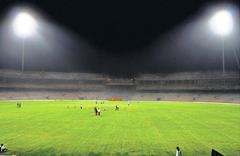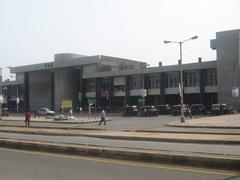Juinagar Railway Station Navi Mumbai: Visiting Hours, Tickets, and Travel Guide
Date: 04/07/2025
Introduction
Juinagar Railway Station is a pivotal transit hub on the Harbour Line of the Mumbai Suburban Railway network, serving as a gateway to Navi Mumbai. Conceived under the strategic urban planning of the City and Industrial Development Corporation of Maharashtra (CIDCO) in the 1970s, Juinagar was envisioned as a well-organized residential node to help decongest Mumbai. Over the years, the station has transformed the locality from a tranquil suburb into a bustling urban center, seamlessly connecting residential, commercial, and educational hubs. Its proximity to major destinations such as the Chhatrapati Shivaji Maharaj Terminus (CSMT), Kurla, and Panvel, and its integration with commercial centers like Mindspace Juinagar and Inorbit Mall, underscores its significance in the city’s urban fabric.
This comprehensive guide explores the history, urban relevance, visiting hours, ticketing options, transport connectivity, accessibility, and nearby attractions around Juinagar Railway Station. Whether you are a commuter, a tourist, or a history enthusiast, this resource will help you make the most of your visit to Juinagar and its surroundings. For further reading on its development and role in Navi Mumbai, see K Raheja Corp Homes and Indian Railways info page.
Table of Contents
- Introduction
- Historical Evolution and Urban Significance
- Visiting Juinagar Railway Station: Hours, Ticketing & Accessibility
- Transport Connectivity & Travel Tips
- Nearby Attractions & Cultural Highlights
- Station Facilities and Safety
- Practical Visitor Tips
- Frequently Asked Questions (FAQ)
- Resources and Official Links
- Summary and Encouragement to Explore Further
Historical Evolution and Urban Significance
The Vision of Navi Mumbai and the Birth of Juinagar
Juinagar’s origins are deeply tied to CIDCO’s vision to create a planned satellite city to relieve Mumbai’s congestion. Developed in the 1970s, Juinagar was designed as an organized residential node with green spaces, modern infrastructure, and a grid-based layout (K Raheja Corp Homes). The establishment of the Harbour Line station transformed Juinagar into a commuter-friendly suburb, attracting a diverse population and catalyzing real estate and economic development (Wikipedia).
Planned Development and Urban Connectivity
Unlike older neighborhoods, Juinagar boasts a grid-style layout, efficient roadways, and ample civic amenities. The flat terrain and proximity to the Arabian Sea lend it a pleasant climate and scenic lushness. The railway station, as a critical node, links Navi Mumbai with Mumbai, facilitating daily commutes and fostering commercial and social vibrancy (K Raheja Corp Homes).
Economic Growth and Integration with Major Projects
Juinagar’s growth has accelerated with the rise of commercial complexes, retail centers, educational institutions, and healthcare facilities. The station’s connectivity has supported a robust rental market and attracted professionals working in nearby IT and industrial zones (Jugyah). Upcoming infrastructure such as the Navi Mumbai International Airport and the Mumbai Trans Harbour Link will further enhance its accessibility and property values (Free Press Journal).
Visiting Juinagar Railway Station: Hours, Ticketing & Accessibility
Visiting Hours and Timings
Juinagar Railway Station operates daily, with services typically running from 4:30 AM to 1:30 AM, corresponding to Mumbai Suburban Railway schedules (Indian Railways Info). Passengers can access the station throughout these operational hours.
Ticketing Options
- Manual Counters & ATVMs: Tickets can be purchased at station counters or Automatic Ticket Vending Machines.
- Digital Ticketing: The UTS mobile app allows for paperless bookings and season passes, ideal for frequent travelers.
- Fares (as of July 2025):
- Second-class ticket to CSMT: ~₹15
- First-class ticket: ~₹120
- Season passes available for regular commuters.
Carry small change or use digital payments for faster transactions, especially during peak times (Mumbai Railway Vikas Corporation).
Accessibility
Juinagar Station provides basic accessibility features such as ramps and designated seating. However, there are currently no elevators or escalators, and wheelchair access is limited. Platforms and train doors are generally level, making boarding easier but assistance may be required for differently-abled travelers.
Transport Connectivity & Travel Tips
Local Transport Options
- Auto-rickshaws and Taxis: Available at the station exit; fares are metered but can be negotiated. Ride-hailing apps like Ola and Uber are also operational.
- NMMT Buses: Several routes connect Juinagar with Nerul, Vashi, CBD Belapur, and other Navi Mumbai nodes (NMMT Official).
- Road Access: Close to Sion-Panvel Highway and Thane-Belapur Road, with ample parking nearby for private vehicles.
Train Services
Trains run every 5–10 minutes during peak hours and 15–20 minutes during off-peak periods. Check real-time schedules on the CR timetable or station digital displays.
Travel Tips
- Avoid peak travel hours (8:00–10:30 AM, 5:30–8:30 PM) for a more comfortable journey.
- Use official railway apps for real-time train and ticketing updates.
- Keep belongings secure and be mindful of crowded platforms.
Nearby Attractions & Cultural Highlights
- Chincholi Talao: A scenic pond popular for Ganeshotsav idol immersions and evening walks.
- Wonders Park: Family-friendly amusement park in Nerul, featuring replicas of world monuments.
- DY Patil Stadium: Renowned for sporting events and concerts.
- Educational and Healthcare Institutions: DY Patil University, Fr. Agnel College, and multi-speciality hospitals.
- Local Markets and Temples: Experience Navi Mumbai’s vibrant community culture.
For historical explorations, visit nearby Panvel Fort or join heritage walks organized by local groups (Jugyah).
Station Facilities and Safety
- Cleanliness: Moderate, with regular waste disposal; public toilets are available but may not meet international standards.
- Drinking Water: Provided via taps and kiosks.
- Security: Managed by GRP and RPF, with CCTV surveillance and patrolling officers. Remain vigilant against petty theft during busy hours.
- Seating and Waiting Areas: Sheltered benches and digital train info boards are present.
- Language: English, Hindi, and Marathi signage for ease of navigation.
Practical Visitor Tips
- Travel Light: Easier movement during rush hours.
- Hydration & Attire: Mumbai is humid; carry water and dress lightly.
- Queue Etiquette: Allow passengers to alight before boarding; avoid blocking doors.
- Photography: Permitted on platforms but drones and professional equipment require permission (Indian Railways Photography Policy).
- Emergency Contacts: GRP (1512), RPF (182).
- Accessibility: Plan ahead if traveling with mobility-impaired companions.
Frequently Asked Questions (FAQ)
Q: What are the visiting hours of Juinagar Railway Station?
A: The station operates from approximately 4:30 AM to 1:30 AM daily.
Q: Are there facilities for differently-abled passengers?
A: Basic accessibility is available, but elevators/escalators are absent. Assistance may be needed.
Q: How can I buy tickets?
A: At counters, ATVMs, or via the UTS mobile app.
Q: What are the best transport options from the station?
A: Auto-rickshaws, taxis, NMMT buses, and ride-hailing apps.
Q: Are there attractions nearby?
A: Yes, Chincholi Talao, Wonders Park, DY Patil Stadium, and historical sites like Panvel Fort.
Resources and Official Links
- K Raheja Corp Homes
- Wikipedia: Juinagar
- Jugyah: Juinagar Neighborhood Guide
- Free Press Journal: CIDCO Tunnel Project
- India Rail Info: Juinagar
- Mumbai Railway Vikas Corporation
- Central Railway Timetable
- Navi Mumbai Municipal Transport
- Mumbai Suburban Railway Official Website
- Swachh Bharat Mission
Summary and Encouragement to Explore Further
Juinagar Railway Station stands as a testament to Navi Mumbai’s planned urban development and strong connectivity. With modern amenities, efficient ticketing, and robust links to major destinations, it is more than a transit point—it’s a launchpad for exploring the city’s commercial, educational, and cultural landmarks. The station’s role in local development, as well as its integration with major infrastructure projects like the upcoming airport and sea link, positions it at the heart of Navi Mumbai’s growth story.
To maximize your visit, use official resources for real-time updates, and consider exploring nearby parks, markets, and historical attractions. Download the Audiala app for personalized travel assistance, and stay connected with local news for the latest on Navi Mumbai’s transport and cultural events.
For more, check out our related guides on “Navi Mumbai Transport Options Explained” and “Top Attractions in Navi Mumbai.”

